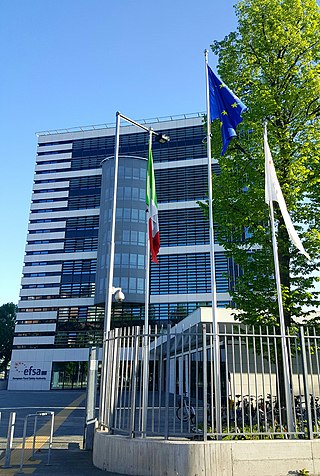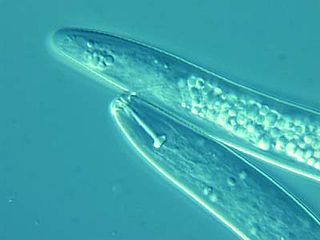
Microcline (KAlSi3O8) is an important igneous rock-forming tectosilicate mineral. It is a potassium-rich alkali feldspar. Microcline typically contains minor amounts of sodium. It is common in granite and pegmatites. Microcline forms during slow cooling of orthoclase; it is more stable at lower temperatures than orthoclase. Sanidine is a polymorph of alkali feldspar stable at yet higher temperature. Microcline may be clear, white, pale-yellow, brick-red, or green; it is generally characterized by cross-hatch twinning that forms as a result of the transformation of monoclinic orthoclase into triclinic microcline.

Allura Red AC is a red azo dye that goes by several names, including FD&C Red 40. It is used as a food dye and has the E number E129.
Phosphated distarch phosphate, is a type of chemically modified starch. It can be derived from wheat starch, tapioca starch, potato starch or many other botanical sources of starch. It is produced by replacing the hydrogen bonds between starch chains by stronger, covalent phosphate bonds that are more permanent. It is manufactured by treating starch with sodium tripolyphosphate (STPP) and sodium trimetaphosphate (STMP), or phosphoric chloride (POCl3). Phosphorylated cross-linked starches is a category of modified food starches within the U.S. Code of Federal Regulations. Starches treated with STMP and STPP must not exceed 0.4 percent phosphorus as residual phosphate.

The European Food Safety Authority (EFSA) is the agency of the European Union (EU) that provides independent scientific advice and communicates on existing and emerging risks associated with the food chain. EFSA was established in February 2002, is based in Parma, Italy, and for 2021 it has a budget of €118.6 million, and a total staff of 542.

Hydroxytyrosol is an organic compound with the formula (HO)2C6H3CH2CH2OH. It is a phenylethanoid, i.e. a relative of phenethyl alcohol. Its derivatives are found in a variety of natural sources, notably olive oils and wines. Hydroxytyrosol is a colorless solid, although samples often turn beige during storage. It is a derivative, formally speaking, of catechol.

Epigallocatechin gallate (EGCG), also known as epigallocatechin-3-gallate, is the ester of epigallocatechin and gallic acid, and is a type of catechin.
Pratylenchus pratensis is a plant pathogenic nematode. Hosts include English holly, oat, corn, alfalfa, strawberry, and clover.

Pratylenchus coffeae is a plant-pathogenic nematode infecting several hosts including potato, banana, sweet potato, strawberry, Persian violet, peanut and citrus.
Pratylenchus goodeyi is a plant pathogenic nematode infecting bananas. It is native to the mountainous regions of Africa. There it is considered the second most devastating nematode after R. similis, especially under poor management.
Pratylenchus brachyurus is a plant parasitic nematode.

Pratylenchus penetrans is a species of nematode in the genus Pratylenchus, the lesion nematodes. It occurs in temperate regions worldwide, regions between the subtropics and the polar circles. It is an animal that inhabits the roots of a wide variety of plants and results in necrotic lesions on the roots. Symptoms of P. penetrans make it hard to distinguish from other plant pathogens; only an assay of soil can conclusively diagnose a nematode problem in the field. P. penetrans is physically very similar to other nematode species, but is characterized by its highly distinctive mouthpiece. P. penetrans uses its highly modified mouth organs to rupture the outer surface of subterranean plant root structures. It will then enter into the root interior and feed on the plant tissue inside. P. penetrans is considered to be a crop parasite and farmers will often treat their soil with various pesticides in an attempt to eliminate the damage caused by an infestation. In doing this, farmers will also eliminate many of the beneficial soil fauna, which will lead to an overall degradation of soil quality in the future. Alternative, more environmentally sustainable methods to control P. penetrans populations may be possible in certain regions.

Pratylenchus neglectus is a plant-pathogenic nematode infecting potato, alfalfa and mint.
Pratylenchus vulnus is a species of plant pathogenic nematode best known for infecting Persian walnut. It is also known to infest potatoes, apricots, peaches and nectarines, holiday cacti, grape and citruses.
Pratylenchus crenatus is a plant pathogenic nematode infecting potatoes.
Pratylenchus flakkensis is a plant pathogenic nematode.
Pratylenchus fallax is a plant pathogenic nematode.
Pratylenchus hexincisus is a plant pathogenic nematode infecting sunflowers.

Pratylenchus is a genus of nematodes known commonly as lesion nematodes. They are parasitic on plants and are responsible for root lesion disease on many taxa of host plants in temperate regions around the world. Lesion nematodes are migratory endoparasites that feed and reproduce in the root and move around, unlike the cyst or root-knot nematodes, which may stay in one place. They usually only feed on the cortex of the root. Species are distinguished primarily by the morphology of the stylets.
Butte is a potato cultivar that was released in 1977.








